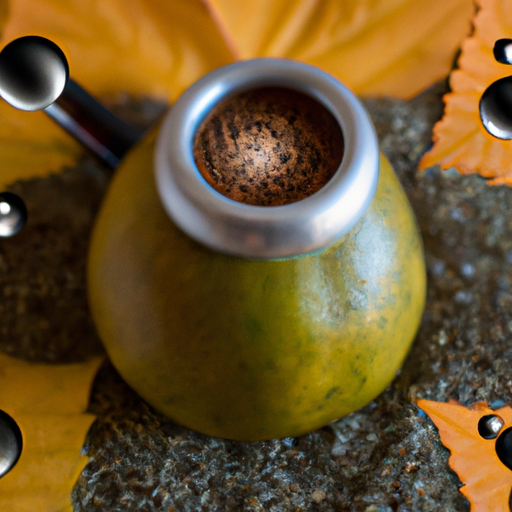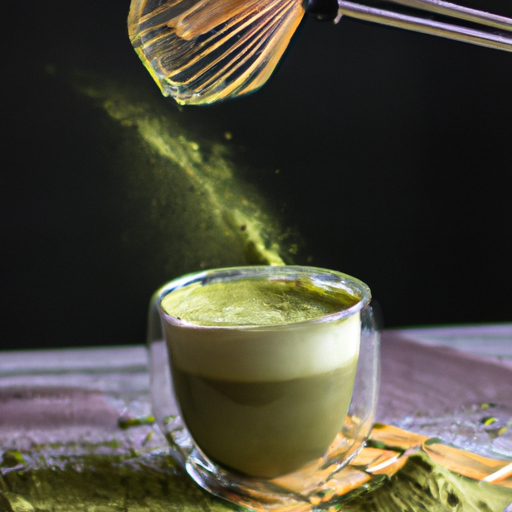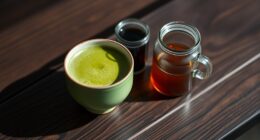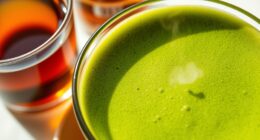Hey matcha enthusiasts! Are you prepared to discover the secrets to brewing a mind-blowing cup of hot matcha? Well, step right up and let me guide you through the process.
First off, let me just say this: I used to think matcha was just another trendy drink that people were obsessing over for no reason. But once I tried it, I realized there’s something truly special about this vibrant green powder.
It’s packed with antioxidants, provides a gentle caffeine boost without the jitters, and has a unique umami flavor that can’t be found in any other tea.
So if you’re curious about trying matcha or want to up your game when it comes to making it at home, stick around and I’ll guide you through every step of the process.
Key Takeaways
- The key to making hot matcha is having a whisk, bowl, and high-quality powder, and mastering the whisking technique.
- Matcha comes in different grades, from ceremonial to culinary, with variations in color, texture, and taste.
- Matcha can be customized with various mix-ins, milk, and flavor combinations to suit personal preferences.
- Health benefits of matcha include improved attention and memory, boosted immunity, and healthy digestion, making it a great addition to anyone’s daily routine.
Choosing the Right Matcha
To get the perfect cup of hot matcha, you’ll need to choose the right matcha powder that will transport your taste buds to a serene Japanese tea garden. The first thing to consider when selecting matcha is its grading.
Matcha is typically classified into three grades: ceremonial, premium, and culinary. Ceremonial grade matcha is made from the youngest leaves and has a bright green color with a smooth texture. Premium grade matcha has a slightly bitter taste but still maintains its vibrant green color. Lastly, culinary grade matcha is used for cooking or making lattes due to its less intense flavor profile.
Aside from grading, it’s also important to consider the flavor profile of the matcha you’re choosing. Different regions in Japan produce different types of matcha that offer distinct flavors and aromas. For example, Uji-matcha has a rich umami flavor while Yame-matcha has a more floral fragrance.
Once you’ve selected the perfect matcha powder for your hot drink, it’s time to gather all necessary tools and ingredients needed for preparation. Without further ado…
Tools and Ingredients
You’ll need a few key items and ingredients to whip up this deliciously cozy beverage. First, you’ll want to invest in a good quality matcha whisk. There are two main types of whisks: the traditional bamboo whisk (chasen) and the electric milk frother. While both will get the job done, purists will argue that only the chasen can create the perfect foam for your matcha.
Secondly, you’ll need a bowl to mix your matcha in. You can use any small bowl, but traditionally a chawan is used during Japanese tea ceremonies. These bowls are often wider and shallower than regular bowls, making it easier to whisk and mix the matcha.
Lastly, you’ll need high-quality matcha powder. Make sure to choose ceremonial grade or premium grade for optimal flavor and health benefits. Additionally, if you want to add some sweetness or creaminess to your drink, consider adding honey or almond milk.
Now that you have all of your tools and ingredients ready, it’s time to learn some basic Matcha ceremony basics before we dive into how to make hot matcha. Understanding these traditions adds an extra layer of appreciation for this exquisite beverage that has been enjoyed by Japanese culture for centuries.
Making the Matcha
Get ready to experience the rich cultural tradition of preparing a warm and frothy cup of matcha with these simple steps.
First, heat up water in a kettle until it reaches about 175-185°F.
Then, sift two teaspoons of matcha powder into a bowl.
Using a bamboo whisk, slowly add hot water to the powder while whisking in back-and-forth motions until you achieve a smooth consistency and froth forms on top.
Mastering the whisking technique is crucial to achieving the perfect hot matcha.
The key is to use quick, zigzagging strokes while holding the whisk at an angle against the bottom of the bowl.
This motion helps create tiny air bubbles that give your matcha its signature frothy texture.
Be sure not to over-whisk as this can result in clumps or bitterness.
Once you have mastered making traditional hot matcha, try experimenting with flavor variations by adding honey or milk for sweetness, or even using almond milk for a dairy-free option.
Customizing your matcha can take it to new heights and make it truly unique!
Customizing Your Matcha
Customizing your matcha allows you to add a personal touch and create a unique flavor experience. Here are three ways to customize your matcha:
-
Mix-ins: Adding mix-ins is an easy way to change the flavor profile of your matcha. Some popular options include honey, agave syrup, vanilla extract, and cinnamon. You can also try adding in some grated ginger or citrus zest for a zesty kick.
-
Milk choices: Instead of using traditional cow’s milk, try experimenting with different types of milk such as almond milk, coconut milk, or oat milk. These alternative milks will add their own unique flavor profiles to the matcha.
-
Flavor combinations: Get creative by combining different flavors together! For example, you could mix in some cocoa powder for a chocolatey twist or add in some lavender oil for a floral aroma.
The possibilities are endless when it comes to customizing your matcha.
Now that you’ve customized your matcha to perfection, it’s time to serve and enjoy! Add ice cubes and blend with a blender for an iced version or pour hot water over the mixture for a warm beverage. Sip slowly and savor every last drop of your custom-made creation!
Serving and Enjoying Your Matcha
Now that your matcha is perfectly personalized, it’s time to enjoy it! Did you know that according to a recent study, drinking matcha can improve attention and memory? So sit back, relax, and savor the delicious taste of your hot or iced matcha.
When it comes to serving matcha, there are many options. For hot matcha, simply whisk together the powder and hot water until frothy. You can also add steamed milk for a creamy latte-like drink. If you prefer chilled drinks, try making an iced matcha by whisking together the powder and cold water or milk with ice cubes.
Pairing your matcha with sweets can enhance the flavors even further. Try pairing a sweet pastry like a croissant or macaron with your hot matcha latte for a perfect breakfast pair. Or if you’re enjoying an iced matcha on a warm day, why not indulge in some fruit sorbet? The possibilities are endless!
As much as we love our custom-made matcha drinks, it’s important to store any unused tea properly so that it maintains its freshness and flavor for future enjoyment without any deterioration over time.
Storing Your Matcha
When it comes to matcha, there are a few questions that come up frequently. One of the most common is how many times you can use matcha before discarding it.
Another question that arises is whether or not matcha is safe for children to consume.
Finally, there’s the question of whether or not it’s okay to drink matcha every day. As someone who enjoys matcha regularly, I’ve done some research on these topics and can offer some insights.
How Many Times Can You Use Matcha?
Although it may vary based on personal preference, a common practice is to use matcha powder for up to three times before discarding. However, this does not necessarily mean that the quality of the matcha will remain consistent throughout each use. As you continue to reuse matcha powder, the flavor and consistency may become weaker with each subsequent use.
If you’re looking for ways to reuse matcha instead of simply discarding it after three uses, there are several options available. One popular method is using leftover matcha as a facial mask due to its antioxidant properties and benefits for skin health. Additionally, some people choose to repurpose used matcha by adding it into smoothies or baked goods as an ingredient.
Moving onto the next topic about ‘is matcha safe for children?’, let’s explore some important considerations parents should keep in mind when introducing their kids to this unique tea beverage.
Is Matcha Safe for Children?
Introducing your little ones to the vibrant green goodness of matcha can be a delightful adventure for their taste buds. Matcha is safe for children and comes with several benefits that make it an excellent addition to their diet.
Here are a few things you should know about serving matcha to kids:
-
Start with small quantities: Children have different tastes, and matcha can be slightly bitter. So, begin by introducing them to a small quantity of matcha and gradually increase the serving size as they develop a liking for it.
-
Don’t add sugar: While it may seem like adding sugar can make matcha more appealing to kids, it’s not necessary. Matcha has natural sweetness that children can enjoy without any added sweeteners.
-
Benefits of matcha for kids: Matcha is packed with antioxidants, vitamins, and minerals that boost immunity, improve cognitive function, and promote healthy digestion in children. It also contains L-theanine which helps calm the mind and improves focus.
When drinking matcha every day becomes a habit, you’ll want to ensure you’re taking the right precautions to avoid overconsumption.
Can You Drink Matcha Every Day?
Sipping on a cup of this vibrant green tea every morning can quickly become a daily ritual for matcha enthusiasts. Not only does it provide an energizing boost, but the benefits of daily matcha consumption are numerous.
Matcha is packed with antioxidants, which can help protect against chronic diseases like cancer and heart disease. It also contains L-theanine, an amino acid that promotes relaxation and helps to improve focus and concentration.
Incorporating matcha into your daily routine is easy. You can add a teaspoon of matcha powder to your morning smoothie or mix it with hot water for a traditional cup of tea. Some people even add it to their baking recipes for a healthy twist on desserts.
With so many versatile ways to enjoy matcha, it’s no wonder why it has gained popularity around the world as a superfood beverage. So go ahead and make drinking matcha a part of your everyday routine!
As you start incorporating more matcha into your life, you may encounter some troubleshooting tips along the way. To ensure that you’re making the most out of your daily dose of matcha, stay tuned for some helpful tips on how to make the perfect cup in our next section.
Troubleshooting Tips
I’ve had my fair share of mishaps when making matcha, and I know how frustrating it can be when your hard work doesn’t pay off.
If you’re experiencing clumpy matcha, watery matcha, or bitter matcha, don’t worry – there are solutions to these common problems.
In this discussion, I’ll go over some troubleshooting tips that’ll help you achieve a perfect cup of matcha every time.
Clumpy Matcha
Don’t let clumps ruin your hot matcha experience – simply sift the powder before adding hot water. Avoiding clumpy matcha is crucial for a smooth and enjoyable cup of tea. Using a sifter is the easiest and most effective way to remove any lumps in the powder. First, place a tablespoon of matcha in the sifter over your bowl or mug. Then, gently tap the sifter so that the powder falls through into the container below. Repeat until all of your matcha has been sifted.
Mixing techniques can also help prevent clumpy matcha. It’s important to use a whisk or milk frother to evenly distribute the powder throughout the liquid without leaving any chunks behind. Additionally, temperature control plays a key role in preventing clumps from forming. If your water is too hot, it can cause the powder to stick together and form lumps. Using lukewarm water instead will help dissolve the powder more easily and create a smoother texture overall. Now that we’ve tackled clumpy matcha, let’s move on to another common issue – watery matcha!
Watery Matcha
To achieve a rich and creamy texture in your matcha, it’s essential to carefully measure the amount of water you use. When making hot matcha, adding too much water can make it watery instead of having that perfect consistency. Here are some tips to help you get your matcha just right:
- Use a small cup or bowl: Using a smaller container will give you better control over the amount of water added.
- Boil the water first: It’s important to boil the water before adding it to your matcha. This ensures that all impurities are removed from the water, which will improve the overall taste.
- Gradually add the hot water: Instead of pouring all of the hot water at once, gradually add it while whisking continuously. This helps prevent clumps and creates a smoother texture.
- Try thickening techniques: If you find that your matcha is still too watery, try using different thickening techniques such as adding milk or coconut cream.
Adding flavor is another way to enhance the taste of your matcha while also helping thicken it up. For example, adding honey or vanilla extract can give it a sweeter taste and thicker consistency. Don’t worry if your matcha turns out bitter; there are steps you can take to fix this issue as well.
Bitter Matcha
If your matcha tastes bitter, there are a couple of ways to reduce the bitterness and bring out a sweeter flavor.
One option is to adjust the amount of powder you use. If you’re using too much powder, it can result in a bitter taste. Try reducing the amount slightly and see if that helps.
Another option is to lower the water temperature. Matcha should be brewed with water that is around 160-175°F (70-80°C). If the water is too hot, it can also lead to a bitter taste. Experiment with different temperatures until you find the sweet spot for your taste buds.
Additionally, consider pairing your matcha with complementary flavors such as honey or vanilla to balance out any bitterness and enhance the overall experience.
Frequently Asked Questions
What are the health benefits of drinking hot matcha?
As someone who regularly drinks hot matcha, I can attest to its numerous health benefits. When comparing matcha to coffee, it’s clear that matcha comes out on top as the healthier option.
Unlike coffee, matcha provides a more sustained energy boost without the crash later on. Matcha also contains high levels of antioxidants which protect against cell damage and inflammation in the body.
Additionally, as someone interested in Japanese culture, I appreciate the role of matcha in traditional Japanese tea ceremonies. Drinking hot matcha is not only good for my physical health but also helps me connect with a rich cultural tradition.
Overall, incorporating hot matcha into my daily routine has been a simple yet effective way to improve my wellbeing and deepen my appreciation for Japanese culture.
Can I use regular green tea instead of matcha for this recipe?
Yes, you can use regular green tea instead of matcha for this recipe. However, there are some differences to keep in mind.
In terms of taste, matcha has a more intense and complex flavor compared to regular green tea. Matcha also contains higher levels of antioxidants and chlorophyll, which provide numerous health benefits such as improved brain function and reduced risk of chronic diseases.
When it comes to weight loss, both matcha and green tea have been shown to increase metabolism and aid in fat burning. However, matcha may be more effective due to its higher concentration of catechins, a type of antioxidant that has been linked to weight loss.
Overall, while using regular green tea is a viable option for making hot tea, choosing matcha over green tea may offer additional health benefits.
How long does it take to prepare hot matcha?
When it comes to preparing hot matcha, the time it takes will depend on your preparation techniques and the optimal temperature you choose. Different types of matcha powder may also have varying prep times.
Generally, it should take no more than a few minutes to whip up a delicious cup of hot matcha. However, I recommend taking your time to ensure that the water is not too hot or too cold and that you’re using high-quality matcha powder for optimal taste and health benefits.
Remember, patience is key when making any type of tea – take a moment to breathe in the aroma and savor each sip. As they say, good things come to those who wait!
Can I add sweeteners like sugar or honey to my matcha?
When it comes to adding sweeteners to matcha, there are certainly some options available. Depending on your personal flavor preferences, you may want to consider using sugar, honey, or even stevia as a way of enhancing the taste of your matcha.
However, it’s important to remember that matcha itself is already quite flavorful and can be quite bitter if not prepared properly. As such, it’s best to start with just a small amount of sweetener and gradually increase as needed until you find the perfect balance for your tastes.
Ultimately, whether or not you choose to add sweeteners is entirely up to you – but it’s definitely worth experimenting with different options until you find what works best for you!
What is the best type of cup or mug to serve hot matcha in?
When it comes to serving hot matcha, the cup or mug you choose can really enhance the overall presentation. There are a few cup options that work particularly well with matcha.
One popular choice is a traditional Japanese tea bowl, which has a wide brim and allows for whisking the matcha vigorously. Another option is a simple ceramic mug with a handle, which makes it easy to hold while enjoying your matcha.
No matter what type of cup you choose, consider adding some presentation ideas such as sprinkling some extra matcha powder on top or adding a decorative garnish like fresh mint leaves or edible flower petals. These little touches can really elevate your hot matcha experience and make it feel special.
Conclusion
In conclusion, making hot matcha is a simple and satisfying experience. You can create your own customized cup of matcha to enjoy whenever you want by following the steps outlined in this article. There are endless possibilities for customization, whether you prefer a traditional preparation or something a bit more unique.
So why not give it a try? Experiment with different grades of matcha and flavorings to find your perfect cup. With just a few simple tools and ingredients, you can create a delicious and healthy drink that will both energize and calm your mind.
As the ancient Japanese proverb goes, "Tea is nectar for the soul."Using the proverb adds an interesting literary device to emphasize on how valuable tea or hot matcha is for one’s well-being.
So sit back, relax, and savor every sip of your homemade hot matcha concoction!










